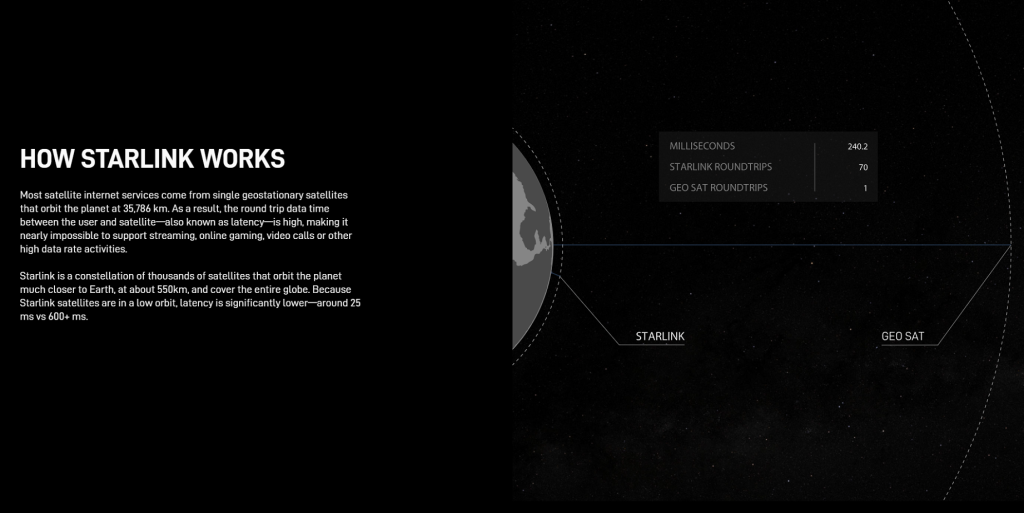
Military Veteran
Discount: $50 OFF

Starlink: Revolutionizing Connectivity with a Global Satellite Network
In an era where staying connected is essential, SpaceX’s Starlink is emerging as a noteworthy solution. Starlink provides high-speed low-latency broadband internet access to Earth through LEO (Low-Earth-Orbit) satellite technology, transforming communication possibilities.
This blog explores Starlink broadband technology and its potential to expand internet connectivity for more businesses and residential recipients, and touches on Starlink installation services.
Starlink currently operates the largest constellation of satellites in low-Earth-orbit (LEO) among all satellite networks. It offers high-speed low-latency internet for activities such as streaming videos, playing online games, accessing healthcare services, social aspects and conducting video calls to name a few. Starlink supplies fast and trustworthy Internet service to people across the globe by employing sophisticated satellites and unique equipment backed by their vast experience in spacecraft and space operations. Starlink utilizes numerous low-Earth-orbit satellites, unlike traditional satellite internet services, which rely on a limited number of distant satellites. This innovative approach seeks to enhance internet services by making them quicker and more dependable, especially in places with weak connections and remote zones.

The majority of satellite internet is provided by a specific type of satellite that remains fixed at an altitude of 35,786 kilometers above the Earth. As a result, the considerable duration required for data to reach the satellite and return complicates activities such as streaming, online gaming, video calls, and other data-intensive tasks. Starlink consists of a network of thousands of satellites orbiting the Earth approximately 550 kilometers (approx. 350 miles) above the surface. They offer global internet access across the entire planet. The proximity of Starlink satellites to the Earth results in a much shorter signal delay of about 25 milliseconds, in contrast to the over 600 milliseconds typical of other satellite networks.
Ground stations, often referred to as gateway stations, communicate with satellites and facilitate the transfer of data between the satellites and the Internet. Ground-based users utilize unique antennas referred to as user terminals to link up with the satellites. These dishes are equipped with unique antennas that can pivot to track satellites, ensuring a consistent connection.
Ground stations transmit data to satellites, which subsequently relay it to users across the globe. The satellites operate at a low altitude, allowing them to transmit data more rapidly and with minimal latency.
Each satellite features a sleek, compact design that minimizes space usage, allowing for efficient packing of multiple units. This enables the complete utilization of the launch strength of SpaceX’s Falcon 9 rocket.
The Starlink satellites are capable of maneuvering on their own to steer clear of orbital debris and other spacecraft. This capability significantly reduces human errors and is highly dependable, surpassing the usual standards found in the industry.
The unique navigation sensors of Starlink observe the stars to determine the location, altitude, and orientation of each satellite. This aids in selecting the correct location for internet coverage.
Starlink is exploring the potential of utilizing space lasers in its satellite operations. By using these lasers, satellites are capable of communicating directly with each other, eliminating the need for ground stations and facilitating worldwide internet access.
Thanks to Starlink LEO satellites offering extensive global coverage. GIS (Geographic Information System) specialists can now access high-speed internet in rural and underserved regions. Starlink satellites operate in low-Earth-orbit (LEO), enabling rapid data transmission with minimal latency. This is crucial for GIS applications that rely on real-time location information to make quick decisions.
The internet in rural locations usually has reduced speeds and bandwidth, complicating the sharing of sizable GIS datasets. To solve this problem, Starlink supplies high-capacity bandwidth and swift data transmission rates. This perk improves the performance of initiatives like cartography, remote sensing, and spatial modeling. You can always consult with your local Starlink installers further about this.
A multitude of satellites within the Starlink system provides a stable and reliable internet service. This holds great importance for GIS applications that are heavily reliant on data, since any service disruption can interfere with essential activities. With its robust backup systems, Starlink offers GIS professionals a trustworthy option that significantly lowers the likelihood of internet interruptions.
Employees frequently require fast data access. Utilizing Starlink’s satellite network, field teams can acquire and transmit geographical data independently of traditional communication infrastructures. This facilitates their communication with the primary GIS databases. This enhances the precision and effectiveness of field surveys, environmental assessments, and disaster response efforts.
Starlink represents a significant advancement in satellite internet technology. The aim is to deliver high-speed internet with minimal latency to the remotest locations globally by utilizing a constellation of satellites positioned near Earth. Despite the challenges that may arise, this technology offers a promising opportunity to unite individuals globally and bridge the divide in digital access. As Starlink continues to evolve and enhance its technology, it is inevitable to influence the future of the internet significantly.
Do you need clarification about selecting the best Starlink installers near you for your business or residential Starlink installation? Your search stops here. Pro Starlink Installers™ is a professional Starlink installation company, offering both online and offline Starlink Installation services at your ease. We also provide free Starlink installation consultation for a better understanding of the products and the services. Our professional Starlink installers offer you the best professional Starlink installation service without any hassle or worry.
For more information, you may call Pro Starlink Installers at 1-888-973-9855
Pro Starlink Installers thank you for taking the time to read this article.